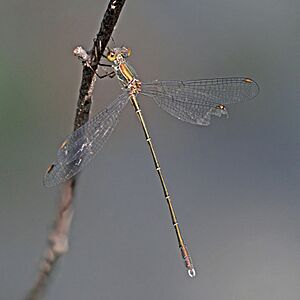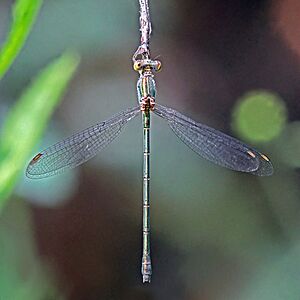Chalcolestes parvidens facts for kids
Quick facts for kids Chalcolestes parvidens |
|
|---|---|
 |
|
| Male | |
 |
|
| Female both in Cyprus |
|
| Conservation status | |
| Scientific classification | |
| Synonyms | |
|
Lestes parvidens Artobelevski 1929 |
The eastern willow spreadwing (scientific name: Chalcolestes parvidens) is a type of damselfly. It belongs to the Lestidae family. This damselfly has a shiny, metallic green body. When it rests, it holds its wings spread out from its body. It used to be known as Lestes parvidens.
Contents
What is a Damselfly?
Damselflies are insects that look a lot like dragonflies. They are often smaller and more slender. When they are resting, most damselflies hold their wings together over their back. But the eastern willow spreadwing holds its wings spread out, which is why it's called a "spreadwing."
About Its Name
The scientific name Chalcolestes parvidens helps scientists around the world know exactly which insect they are talking about. The genus name Chalcolestes is different from Lestes. This change happened because scientists found differences in their young, called larvae. C. parvidens is very similar to another damselfly, C. viridis. For a long time, people thought they were the same species. But small differences in their bodies and even their proteins showed they are actually two separate species. Still, it can be hard to tell them apart in nature!
Where It Lives
The eastern willow spreadwing lives in parts of eastern and central Europe. You can find it in countries like Croatia, Bulgaria, Greece, Italy, Syria, Jordan, Israel, and Turkey. It also lives on islands in the eastern Mediterranean Sea. These islands include Cyprus, Corsica, Crete, and Sicily. In some places, like Italy and the Balkans, both C. parvidens and C. viridis live side by side. Scientists have only recently started telling these two species apart. So, some older records might have mixed them up.
How to Identify It
It is very difficult to tell C. viridis and C. parvidens apart just by looking at them in nature. Both damselflies are mostly metallic green. They are larger and darker than many other Lestes damselflies. However, they do not have the powdery blue coating that is common in some Lestes species.
- Wings: The small, colored spot near the tip of their wings, called the pterostigma, is pale brown. It has a thin black outline.
- Body: Their thorax (the middle part of their body) has thin yellow lines. It also has a wider yellow stripe on each side. This stripe has an uneven top edge.
- Special Mark: Both C. viridis and C. parvidens have a clear spur-like mark on the side of their thorax. This can help identify them as a spreadwing.
Its Life and Habits
Eastern willow spreadwings are usually seen flying from May to November. In warmer places like Cyprus, they can fly from early April all the way to January.
- Resting: They often hang with their wings spread wide. You can usually find them in the shade of trees near water. This is where they breed.
- Mating: Mature males protect areas in shrubs and small trees. They look for females there. When a male and female mate, they form a special "wheel position."
- Egg Laying: The female lays her eggs with the male still attached. They lay their eggs into cuts they make in the bark of tree branches. These branches hang over the water. This is different from many damselflies that lay eggs in plants under the water.
- Galls: Sometimes, the egg-laying can cause oval-shaped bumps, called galls, to form on the tree bark.
- Overwintering: The eggs develop quickly for a few weeks. Then, they enter a "diapause" state. This means their development slows down a lot. The eggs stay in this slow state through the winter.
- Hatching: In the spring, the eggs hatch. The tiny larvae drop into the water and start to grow. They grow very fast. New adult damselflies can appear in just a couple of months.
- Maturing: After they become adults, they fly away from the water. They need time for their bodies to fully mature and for their reproductive organs to develop. During this time, they cannot breed. This also stops them from laying eggs too early in the year. If eggs were laid too early, they might hatch before winter. The young larvae would then die when cold temperatures arrive.
- Breeding: Once they are fully mature, the adults return to the water to start breeding.
See also
- Lestidae
- List of damselflies of the world (Lestidae)


